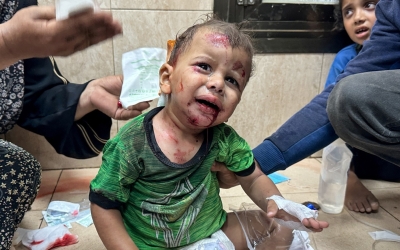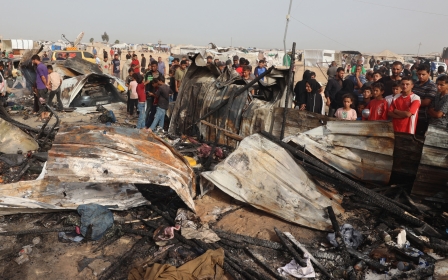War on Gaza: The TikTok generation is seeing the truth about Israel

Gaza is now likely to have the largest number of child amputees of any conflict in modern history.
In January, Unicef estimated that around 1,000 children in Gaza had lost one or both their legs - equivalent to 10 children losing legs every day.
That number has risen enormously in line with Israel’s ongoing onslaught through densely populated areas in a strip no longer than a marathon route.
Earlier this month, amid a growing death toll, made up predominantly of women and children, the UN announced it would add Israel to a blacklist of countries and organisations harming children in conflict zones. To many, this is about seven months overdue.
One of the challenges of telling the truth about the effects of Israel’s war on Gaza’s civilian population has been the refusal by Israeli authorities to allow access to foreign journalists into Gaza.
New MEE newsletter: Jerusalem Dispatch
Sign up to get the latest insights and analysis on Israel-Palestine, alongside Turkey Unpacked and other MEE newsletters
While Palestinian journalists have been killed in record numbers covering the massacre of their own people, no foreign news outlets have pushed hard enough for access for their own journalists.
This has meant the conflict has been heavily skewed in favour of an Israeli official narrative, designed to protect the framing of the violence as defensive, despite its continuity with a history of ethnic cleansing, and the huge level of harm to all forms of life and infrastructure.
Disturbing realism
Channel 4 in the UK has been one of the few outlets committed to centring Palestinian perspectives in its coverage, despite the challenges at hand.
Kill Zone: Inside Gaza by C4’s Dispatches is one of the most disturbing films I have ever watched.
Follow Middle East Eye's live coverage of the Israel-Palestine war
Like many, I have been ingesting a steady diet of horrifying images from Gaza for the last eight months, but even with knowing what I do, I was and remained harrowed.
In one scene, the uncle of a toddler who has lost both his parents and his legs, stands before his hospital bed in a crowded corridor holding back tears. “He doesn’t know yet,” he tells the camera. “He doesn’t know about his parents or his legs.”

The intensity of the pain he would have to convey to this small child, lying in shock with bandaged stumps, burned through his tired eyes.
Taking us through months of bombings and displacement, and highlighting the reality for Palestinians that there are no safe places in Gaza today, the film is a small drop of deeply disturbing realism in a sea of Israeli disinformation.
As such, it highlights the power of this disinformation in providing the necessary window-dressing for media corporations and politicians to continue to justify this assault, given that were these images the norm on our news reports, as they are on our social media feeds, it is hard to believe the same "this is self-defence" or "what about Hamas?" lines could hold at all.
While the film clearly wrestled with the challenge of access to continuous footage from the same sources, it brought to the fore the immense toll the conflict has had on individuals risking their lives to tell the stories.
One Palestinian journalist covers the killing of his twin brothers and father in the bombing of a residential neighbourhood, only later to also cover an attack which also injures his sister. The losses are too great even through the screen.
'All Eyes on Rafah'
Much has been said about the generational shift happening around attitudes to Palestine - a recent poll suggested a majority of Britain’s young people did not believe Israel should exist and that a majority of young people in America sympathised more with Palestinians than they did with Israelis, with 34 percent saying that Hamas’s reasons for fighting Israel were valid.
“They told people to evacuate, and they hit them.”
— Channel 4 Dispatches (@C4Dispatches) June 5, 2024
Paramedic Yousef Hindi rushes to treat civilians in an ambulance convoy, hit by an Israeli air strike.
Watch @C4Dispatches Kill Zone: Inside Gaza - streaming now on @Channel4. pic.twitter.com/WtZrygVNxo
As social media has taken over the delivery of information to younger audiences, with raw footage from shaky iPhones in Gaza relaying the depths of the horror, many mainstream news platforms have lost credibility with younger people, who were already less likely to watch them.
The dissonance between the images they are seeing from original sources, or from people they might otherwise know or trust on social media, has deepened an already growing generational chasm on attitudes to Palestine. This is rooted in no small part in the disinformation mainstream news platforms have allowed Israeli officials to continue to spread, in the face of mounting war crimes.
Today, the reality of an occupied Palestinian people’s need for self-determination and their national liberation struggle in the face of a brutal occupation has never been clearer to young people.
An AI-generated “All Eyes on Rafah” graphic was shared more than 44m times on Instagram, and pro-Palestine content is proliferating on TikTok, where activists claim there is less censorship than through US-owned Meta.
All eyes on #Rafah 🇵🇸 pic.twitter.com/bg3bAtl3dQ
— The Palestinian (@InsiderWorld_1) May 27, 2024
C4’s Dispatches and its more balanced coverage as compared to its counterparts is welcome, but younger audiences increasingly see through the hasbara spin and beyond the narrow permissibility of seeing Palestinians either as terrorists or victims.
Guilty penance
The time is now for Palestinians to be depicted with the dignity they deserve - in their own voice, with their own aspirations, including for the success of the national liberation movement.
While liberal media has often confused pitying depictions of Palestinian victims as balanced coverage, it is no such thing - it is a guilty penance for the reality of the horrors they know are unfolding but which they do not cover accurately.
This is no longer about pitying wounded children - it is about holding Israel truly accountable for its crimes and giving voice to an occupied people’s call for freedom
In newsrooms across the western world, journalists have cried through editorial meetings, hidden in toilets to scream and even been sacked for trying to confront the bias.
There is a battle within western journalism happening alongside the conflict, one designed to provide ideological cover for one of the worst horrors of the 21st century, despite the profession’s commitment to "facts".
True editorial justice on this story involves allowing the Palestinian liberation movement to be heard on its own terms. This is no longer about pitying wounded children - it is about holding Israel truly accountable for its crimes and giving voice to an occupied people’s call for freedom; freedom from occupation, freedom from apartheid, freedom from violence.
Palestinians deserve justice and those watching their struggle through screens around the world are increasingly aware and on board.
It’s about time the mainstream media caught up, or else they risk losing their remaining credibility to the TikTok brigade.
The views expressed in this article belong to the author and do not necessarily reflect the editorial policy of Middle East Eye.
Middle East Eye delivers independent and unrivalled coverage and analysis of the Middle East, North Africa and beyond. To learn more about republishing this content and the associated fees, please fill out this form. More about MEE can be found here.





